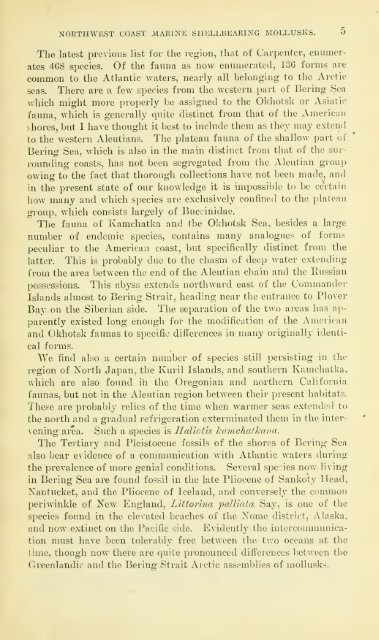United States National Museum - si-pddr - Smithsonian Institution
United States National Museum - si-pddr - Smithsonian Institution
United States National Museum - si-pddr - Smithsonian Institution
You also want an ePaper? Increase the reach of your titles
YUMPU automatically turns print PDFs into web optimized ePapers that Google loves.
NORTHWEST COAST MARINE SHELLBEARING MOLLUSKS. O<br />
The latest previous list for the region, that of Carpenter, enumer-<br />
ates 468 species. Of the fauna as now enumerated, 13G forms are<br />
common to the Atlantic waters, nearly all belonging to the Arctic<br />
seas. There are a few species from the western part of Bering Sea<br />
which might more properly be as<strong>si</strong>gned to the Okhotsk or A<strong>si</strong>atic<br />
fauna, which is generally quite distinct from that of the American<br />
shores, but I have thought it best to include them as they may extend<br />
to the western Aleutians. The plateau fauna of the shallow part of<br />
Bering Sea, which is also in the main distinct from that of the surrounding<br />
coasts, has not been segregated from the Aleutian group<br />
owing to the fact that thorough collections have not been made, and<br />
in the present state of our knowledge it is impos<strong>si</strong>ble to be certain<br />
how many and which species arc exclu<strong>si</strong>vely confined to the plateau<br />
group, which con<strong>si</strong>sts largely of Buccinidae.<br />
The fauna of Kamchatka and the Okhotsk Sea, be<strong>si</strong>des a large<br />
number of endemic species, contains many analogues of forms<br />
peculiar to the American coast, but specifically distinct from the<br />
latter. This is probably due to the chasm of deep water extending<br />
from the area between the end of the Aleutian chain and the Kus<strong>si</strong>an<br />
posses<strong>si</strong>ons. This abyss extends northward east of the Commander<br />
Islands almost to Bering Strait, heading near the entrance to Plover<br />
Bay on the Siberian <strong>si</strong>de. The separation of the two areas has apparently<br />
existed long enough for the modification of the American<br />
and Okhotsk faunas to specific differences in many originally identi-<br />
cal forms.<br />
We find also a certain number of species still per<strong>si</strong>sting in the<br />
region of North Japan, the Kuril Islands, and southern Kamchatka,<br />
which are also found in the Oregonian and northern California<br />
faunas, but not in the Aleutian region between their present habitats.<br />
These are probably relics of the time when warmer seas extended to<br />
the north and a gradual refrigeration exterminated them in the intervening<br />
area. Such a species is IIallot is kamchathana.<br />
The Tertiary and Pleistocene fos<strong>si</strong>ls of the shores of Bering Sea<br />
also bear evidence of a communication with Atlantic waters during<br />
the prevalence of more genial conditions. Several species now living<br />
in Bering Sea are found fos<strong>si</strong>l in the late Pliocene of Sankoty Head,<br />
Nantucket, and the Pliocene of Iceland, and conversely the common<br />
periwinkle of New England, Littorina palliata Say, is one of the<br />
species found in the elevated beaches of the Nome district. Alaska,<br />
and now extinct on the Pacific <strong>si</strong>de. Evidently the intercommunica-<br />
tion must have been tolerably free between the two oceans at the<br />
time, though now there are quite pronounced differences between the<br />
Greenlandic and the Berinjr Strait Arctic assemblies of mollusks.

















